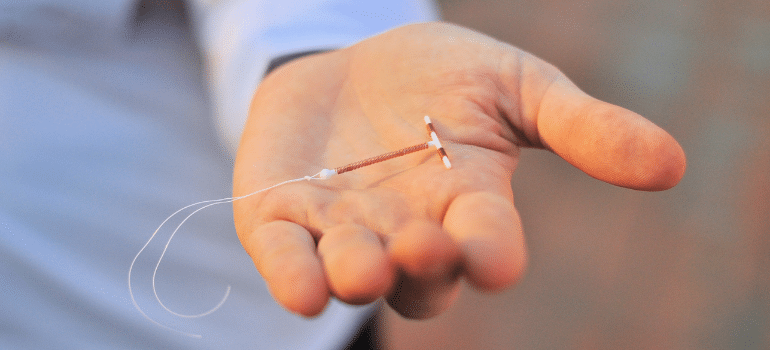Women’s Health
Want to learn more about this at Kettering Health?
It might be difficult for a woman to decide which method of contraception is right for her, as so many choices are available. One option is an intrauterine device (IUD).
There is a lot to understand about IUDs, as different types can be used to treat different symptoms such as heavy period bleeding. But by working closely with her OB-GYN, a woman can determine if this is the right contraception option for her.
What is an IUD?
An IUD is a small, t-shaped birth control device that is inserted into the uterus to prevent pregnancy. There are both hormonal and non-hormonal options.
According to Dr. Andrew Chang, OB-GYN, both versions are plastic, but the non-hormonal version is coated in copper, and the hormonal version contains a progesterone hormone.
Why consider an IUD?
IUDs are a popular method of contraception for many reasons, from their effectiveness to minimal side effects.
Once inserted, the copper IUD is effective for 10 years. The placement process is the same as for the progastrin hormonal IUD. However, there are reasons women would be interested in this IUD over the other type.
“It is really for the patient who is nervous about hormones altogether. Or somebody who wants to continue to have their period,” Dr. Chang explains. “It basically works by creating an environment that can’t sustain a pregnancy.”
The hormonal IUDs are effective for five years and have low failure rates. These IUDs can affect a women’s endometrium, which is a layer of the uterus. This means that a woman’s periods might be lighter—or even nonexistent—if she uses the hormonal IUD.
“They work really well. The reason I tend to like the hormonal IUDs better is they have some effect on the endometrium,” Dr. Chang says. “Sometimes a side effect is lighter periods, and after a year some patients have no periods.”
Other benefits
With hormonal birth control such as pills, patches, and vaginal rings, there is a risk of human error. The patient might forget to take her pill or replace her patch, which makes the birth control method less effective.
IUDs take that degree of human error out of the picture. Once one is inserted, the patient can forget about it and not be responsible for remembering to take or replace something.
The hormonal IUD can also be used to treat abnormal uterine bleeding.
Preparation and insertion
Some providers may pretreat the patient if they suspect inserting the IUD through the cervix will be difficult. The patient is given medication the night before and sometimes the morning of the procedure to open up the cervix and make the process easier.
Dr. Chang recommends the patient take ibuprofen prior to her appointment to counteract any cramping she might experience.
The actual placement is very similar to a pap smear as far as insertion. The patient will experience moderate to heavy cramping during the procedure. However, the procedure itself is typically very quick and over in only a few minutes.
Afterwards, patients are told to insert nothing in the vagina for two days. The string of the IUD will hang down into the vagina just enough to where it can be felt by the tips of a woman’s fingers if she checks herself.
In one or two weeks the doctor will perform a string check to make sure the IUD is still in the proper place.
Side effects
It is rare for a patient to experience side effects. For the most part, the use of an IUD has a positive impact on a woman’s period and health. However, Dr. Chang warns that at first there will be random spotting and bleeding.
“The last thing I counsel patients on is to expect there to be abnormal bleeding at first. The bleeding profile can vary—everybody is a little bit different. We encourage patients to follow up instead of going straight to wanting it out. There are things we can do to manage side effects, specifically the bleeding,” Dr. Chang says.
Minor side effects, though unlikely, include
- Weight gain
- Acne
- Mood swings
The patient is counseled to monitor for heavy bleeding, fever, and severe pain that is not controlled by over-the-counter medication. Patients should also watch for these rare possibilities:
- Spontaneous expulsion of the IUD from the body
- Lost string
- The IUD migrating from the uterus to another area
Patients are also instructed to monitor their string and whether they can feel it themselves. If a patient cannot feel her IUD string, she should call her doctor to make sure the device is still in place.
What IUDs can’t do
IUDs are very effective in preventing pregnancy, but they do nothing to protect against sexually transmitted diseases (STDs).
“We always recommend that you use a form of barrier contraception, because it prevents STDs, which can have long-lasting effects,” Dr. Chang says.










